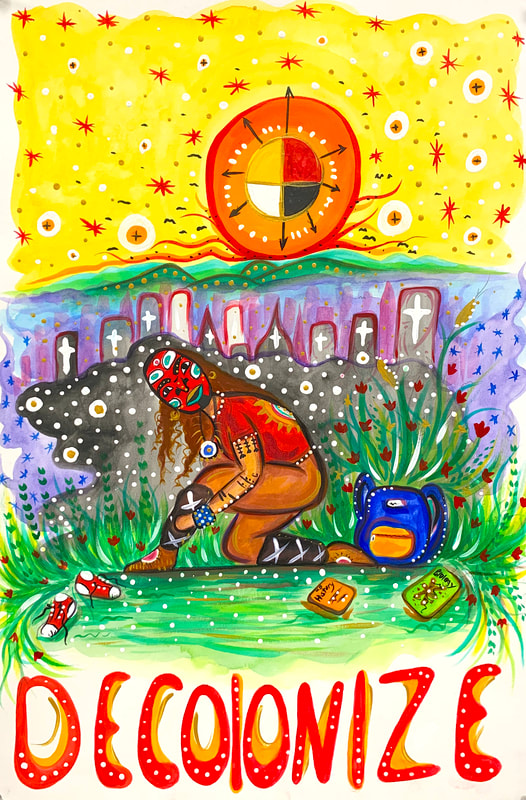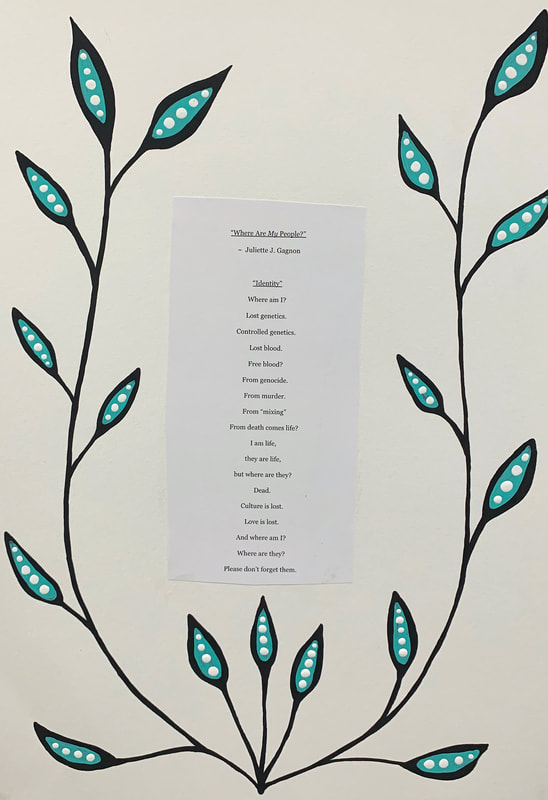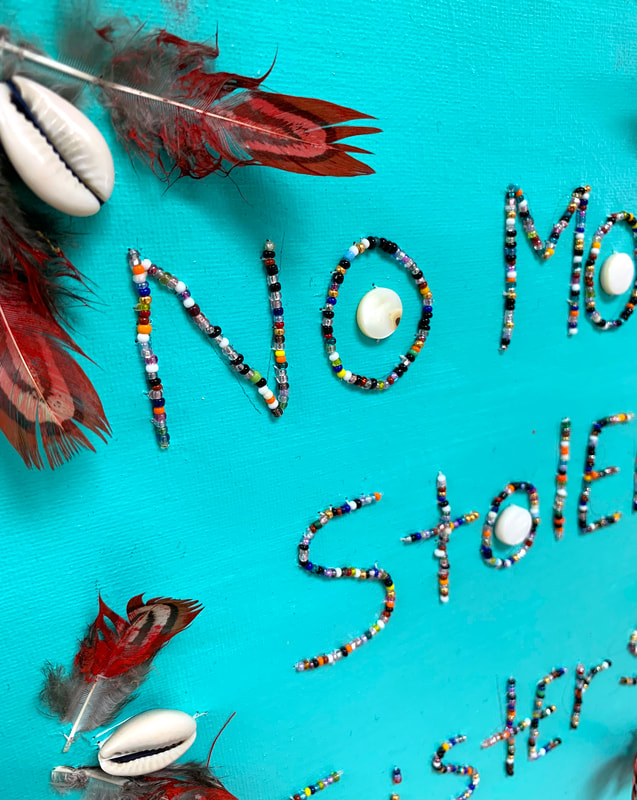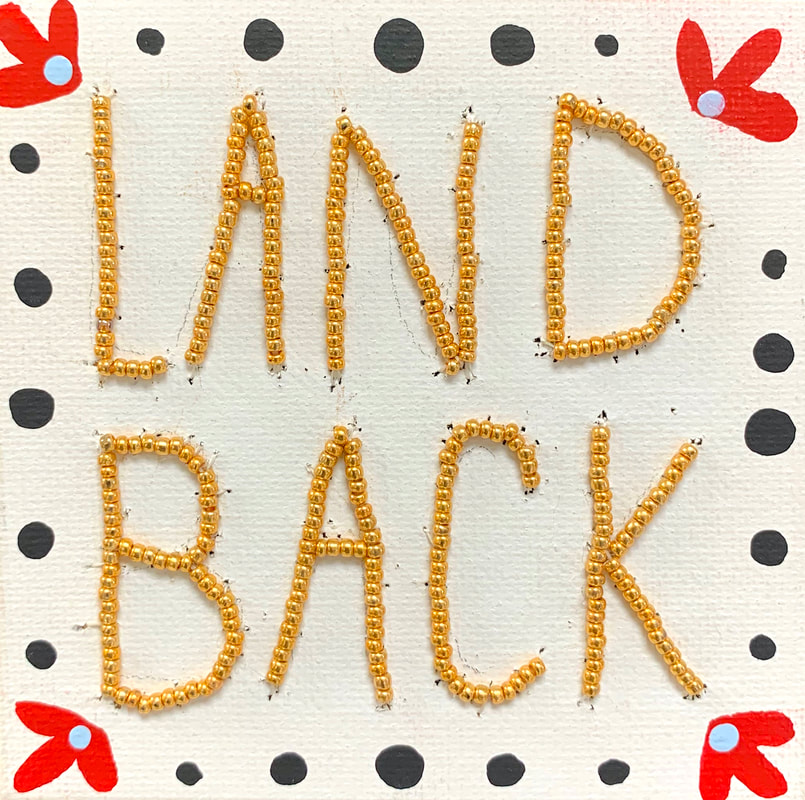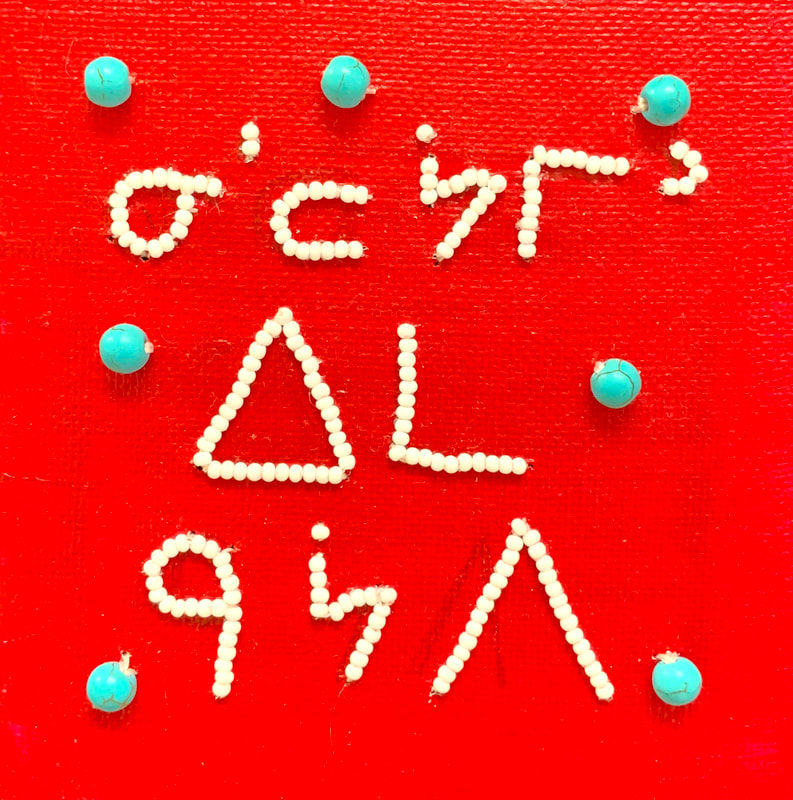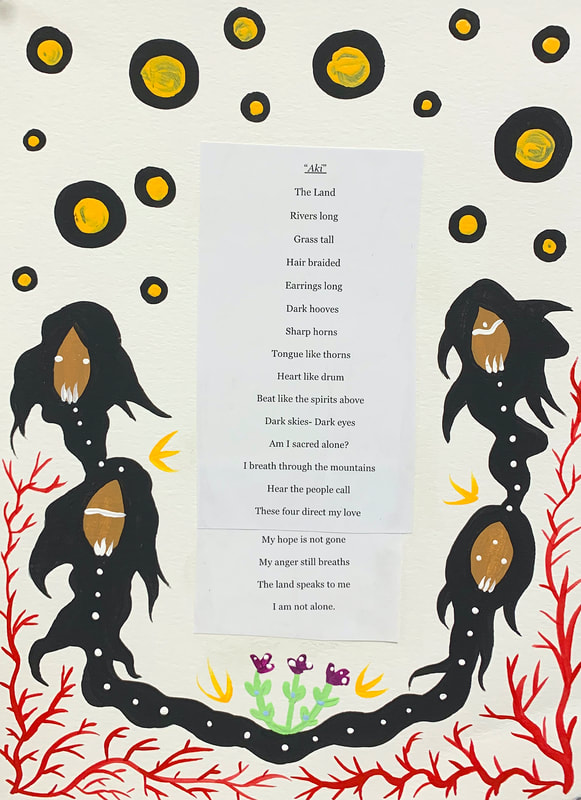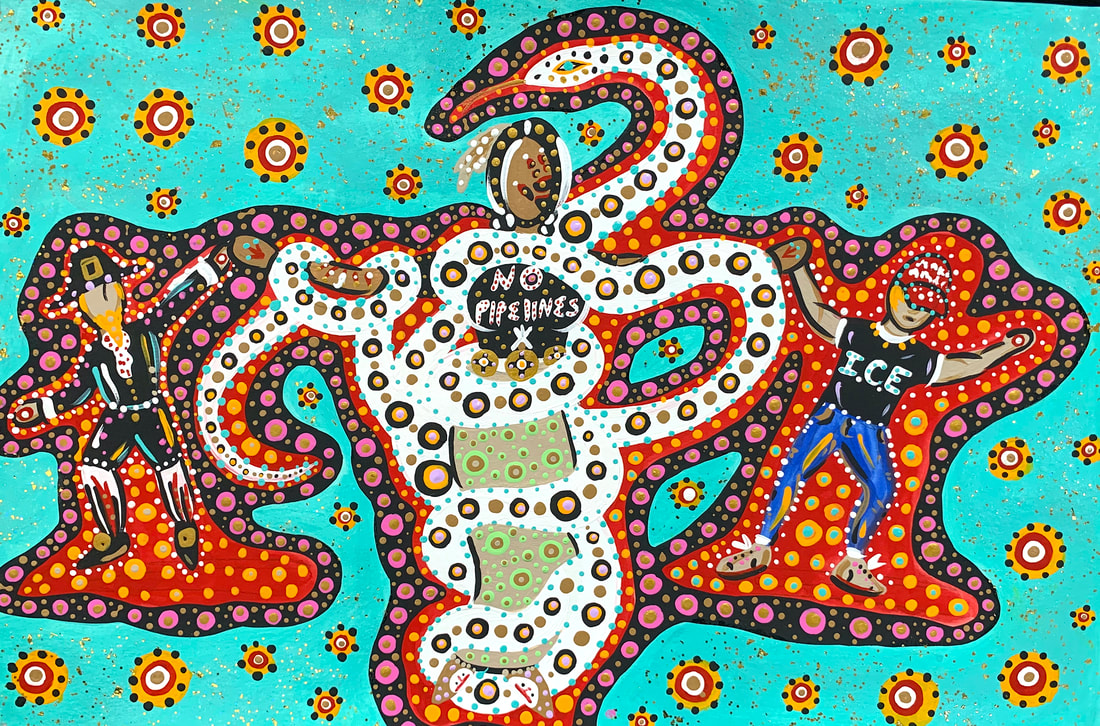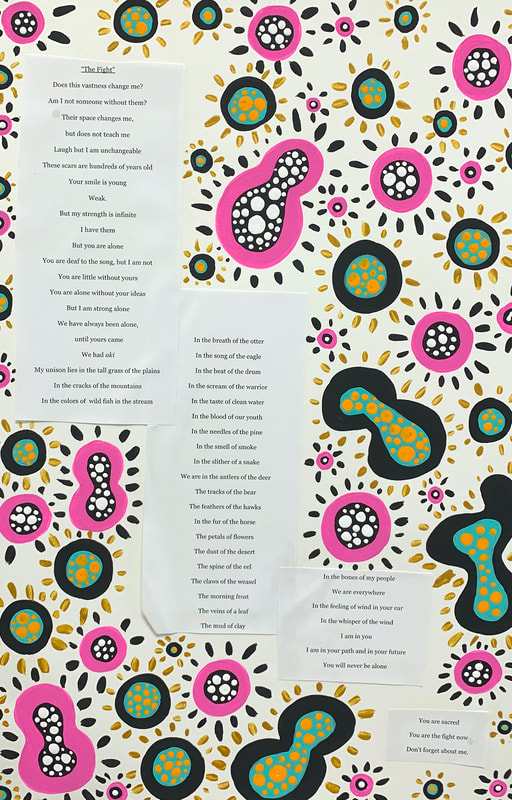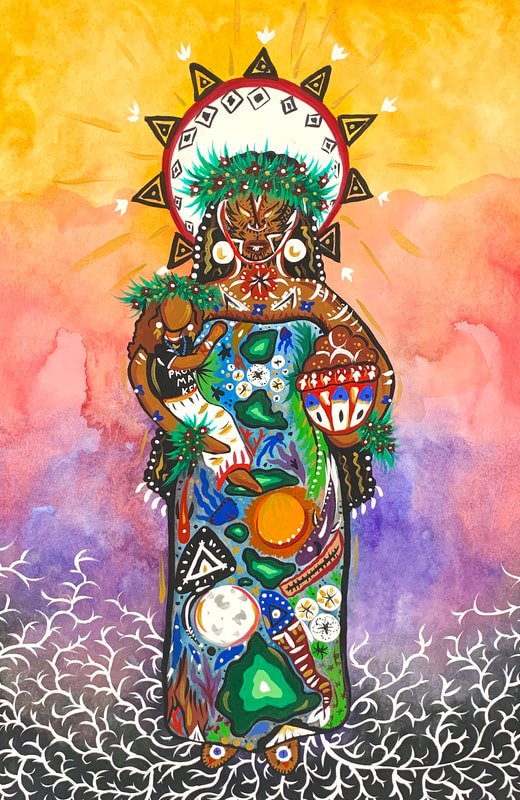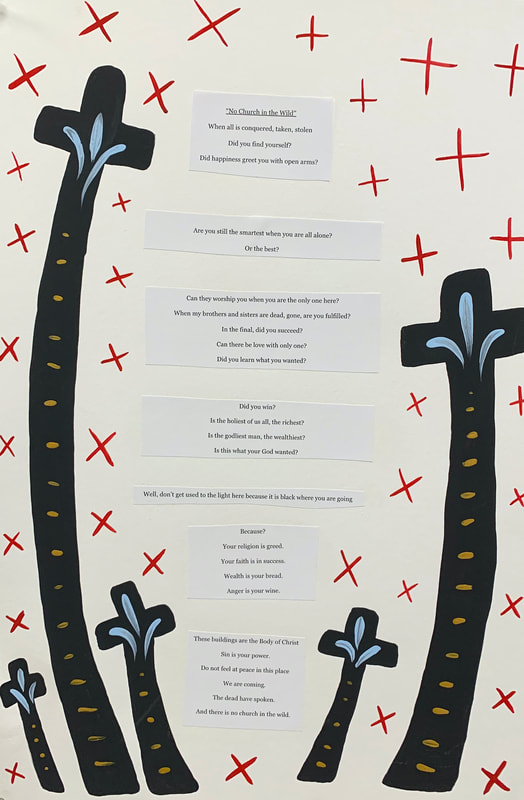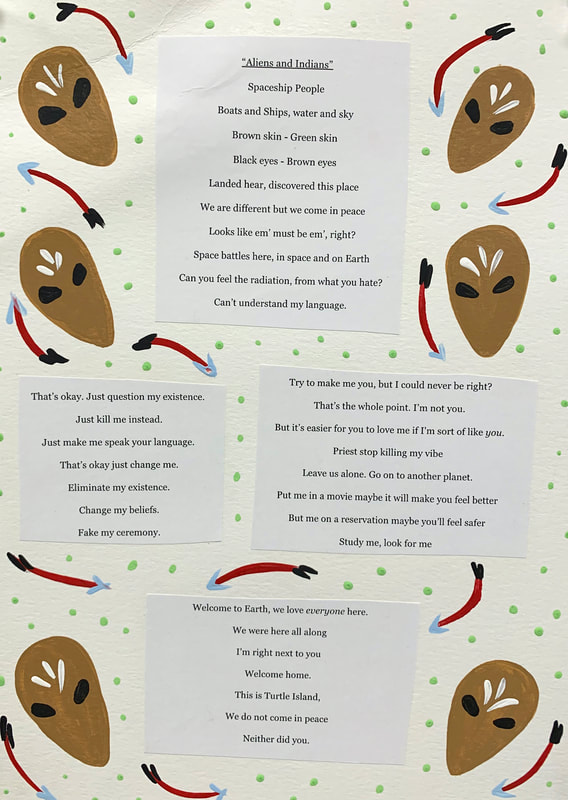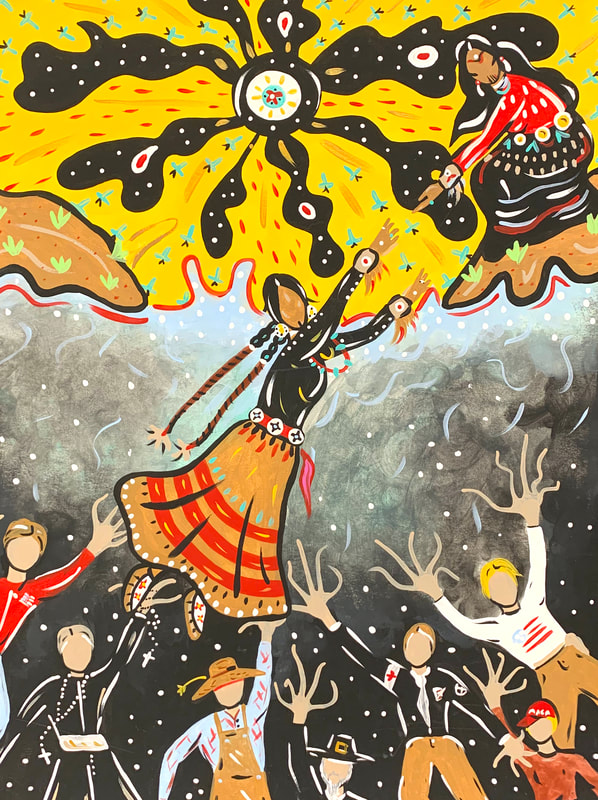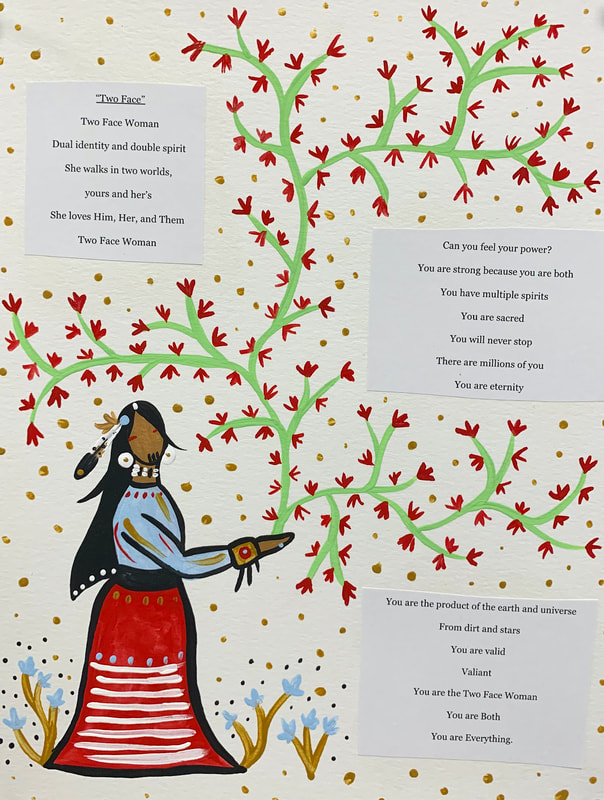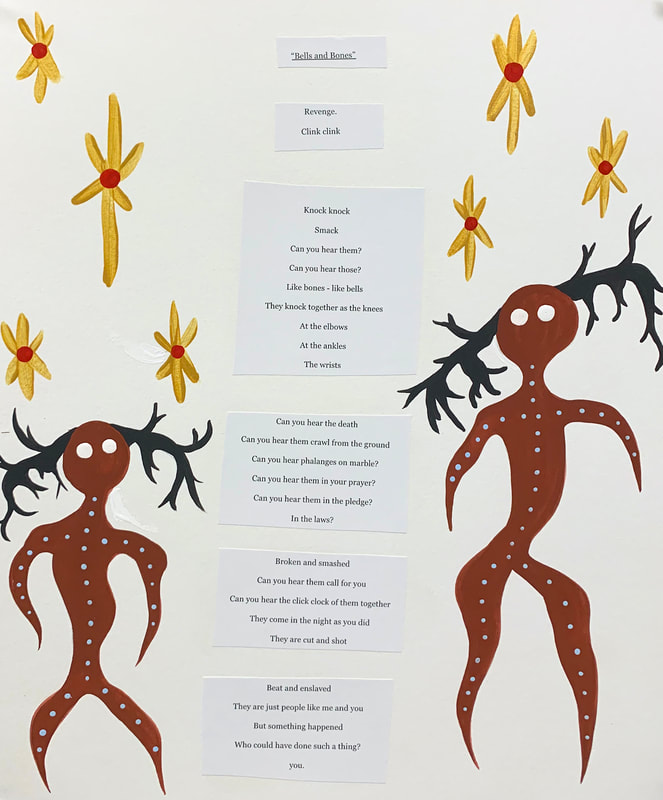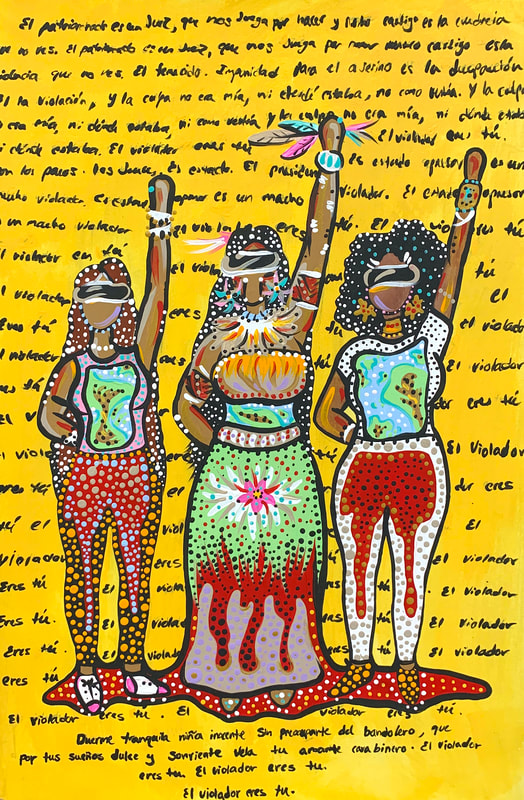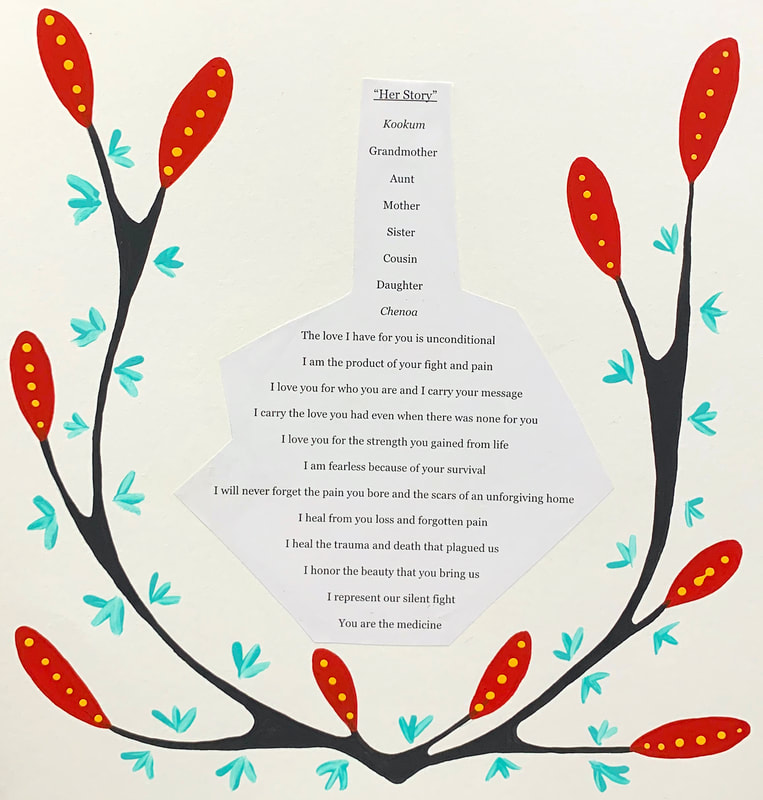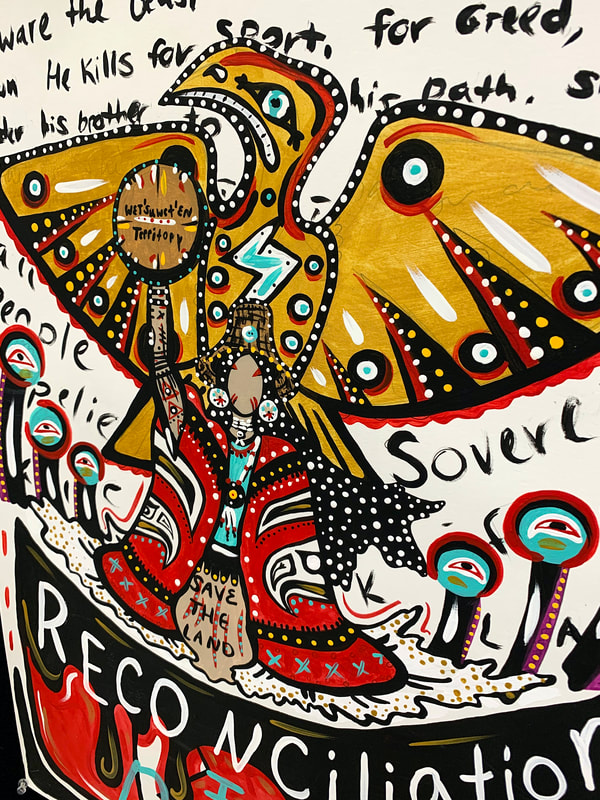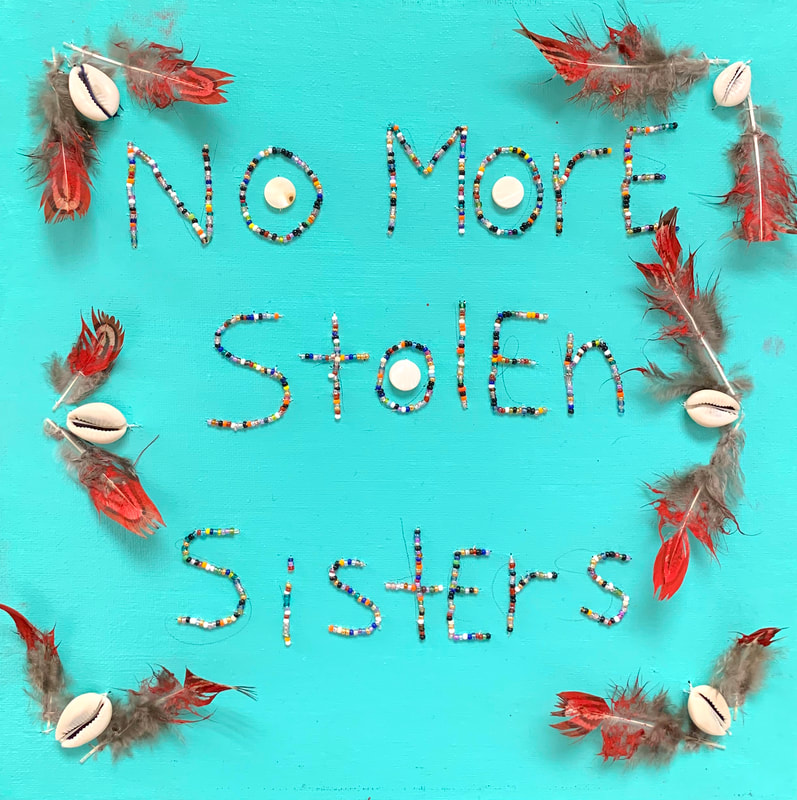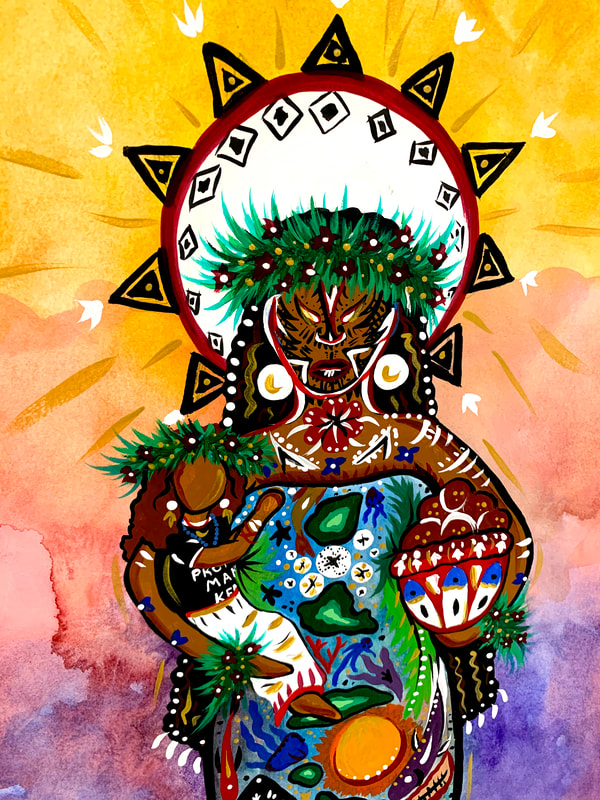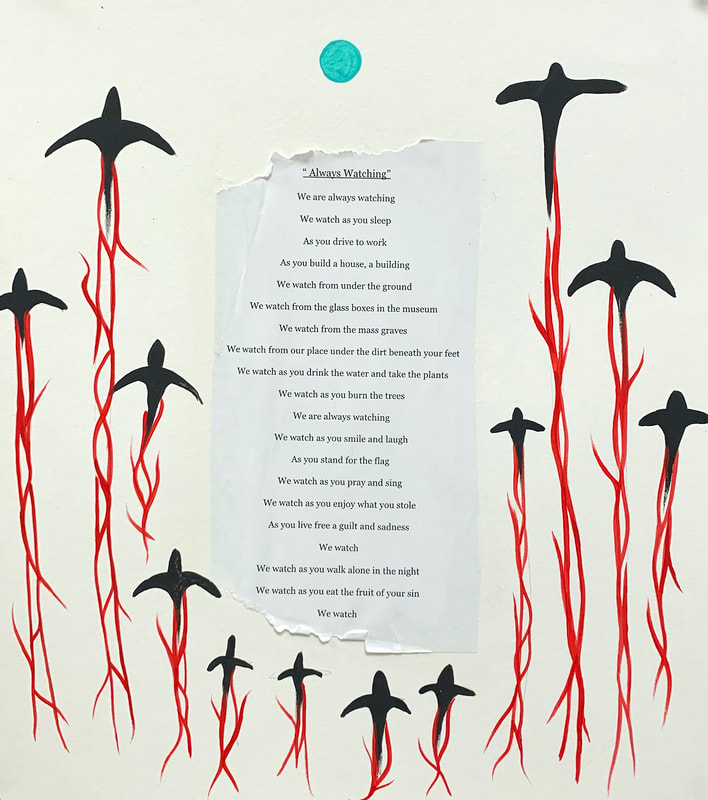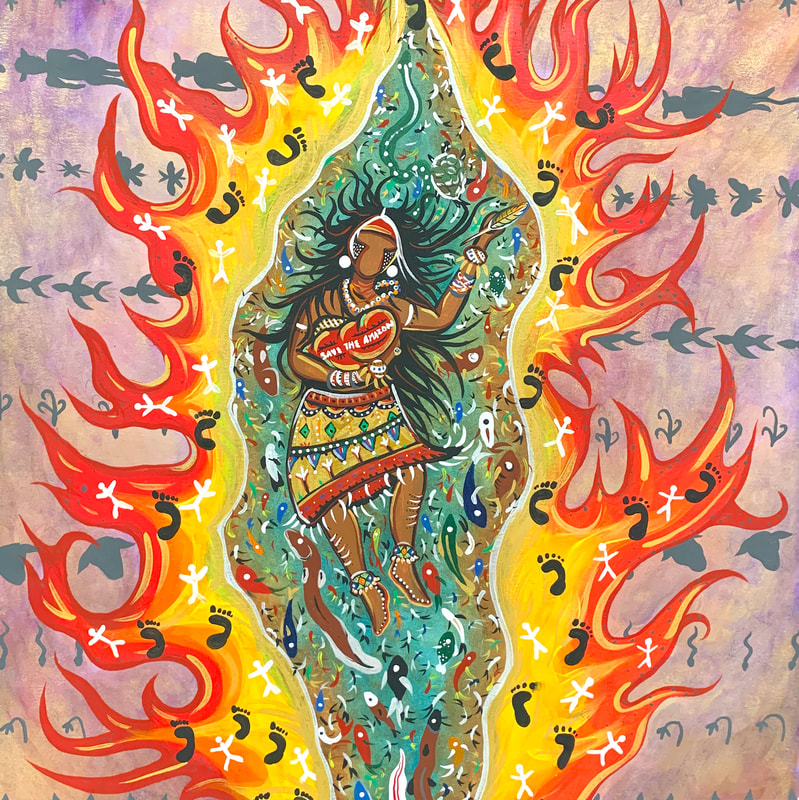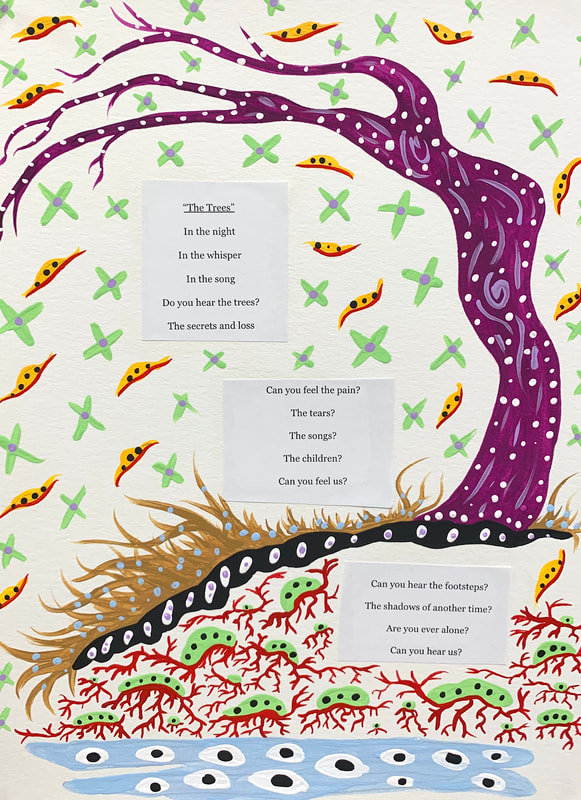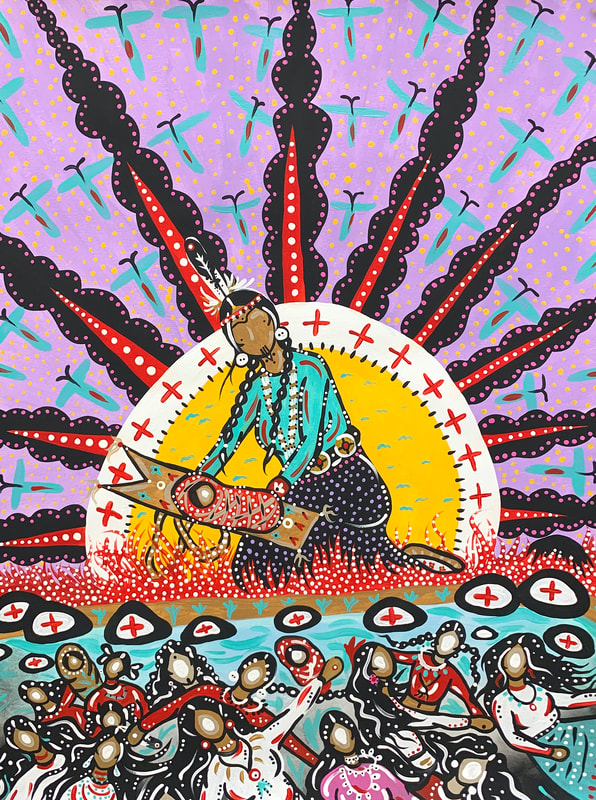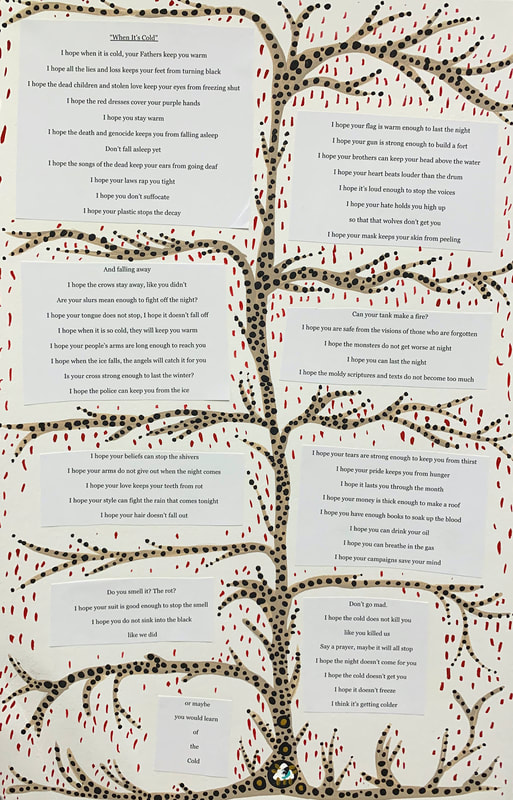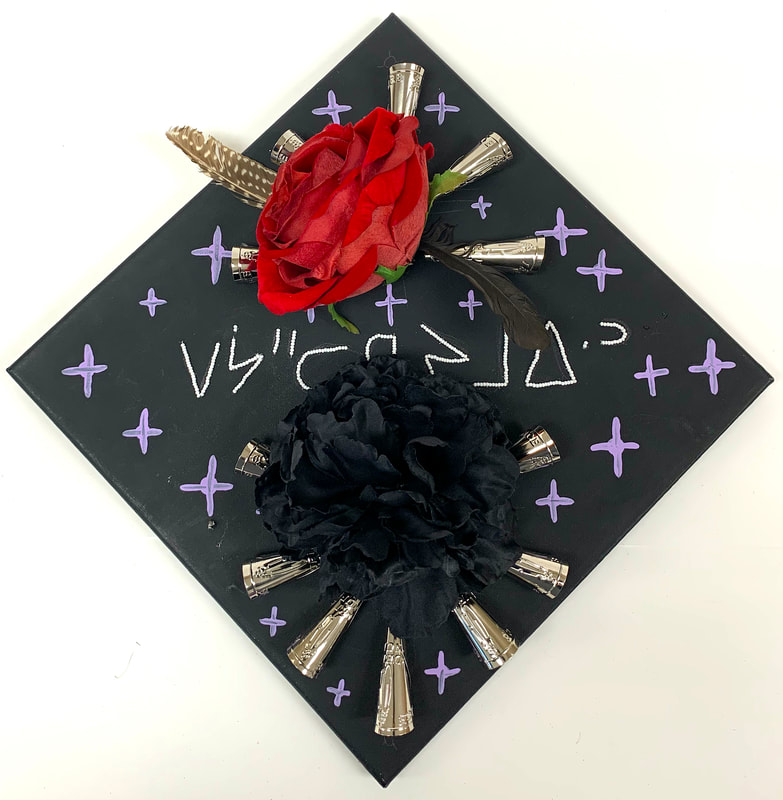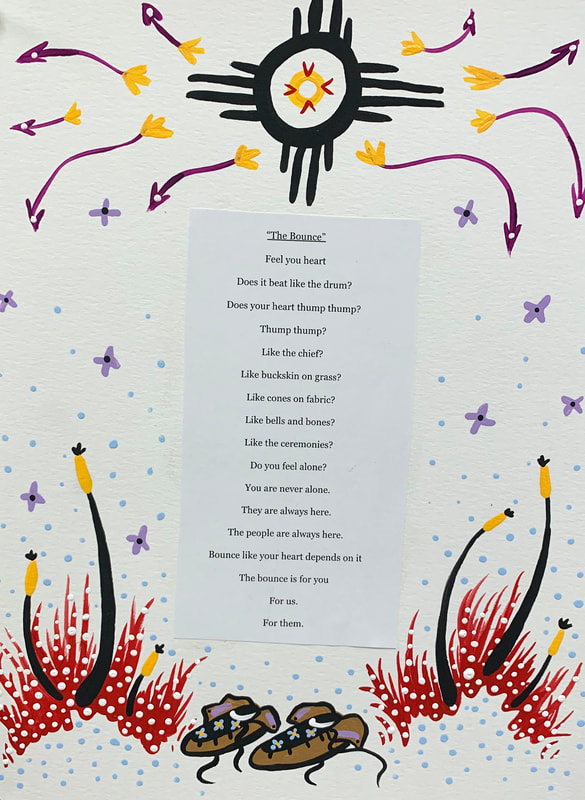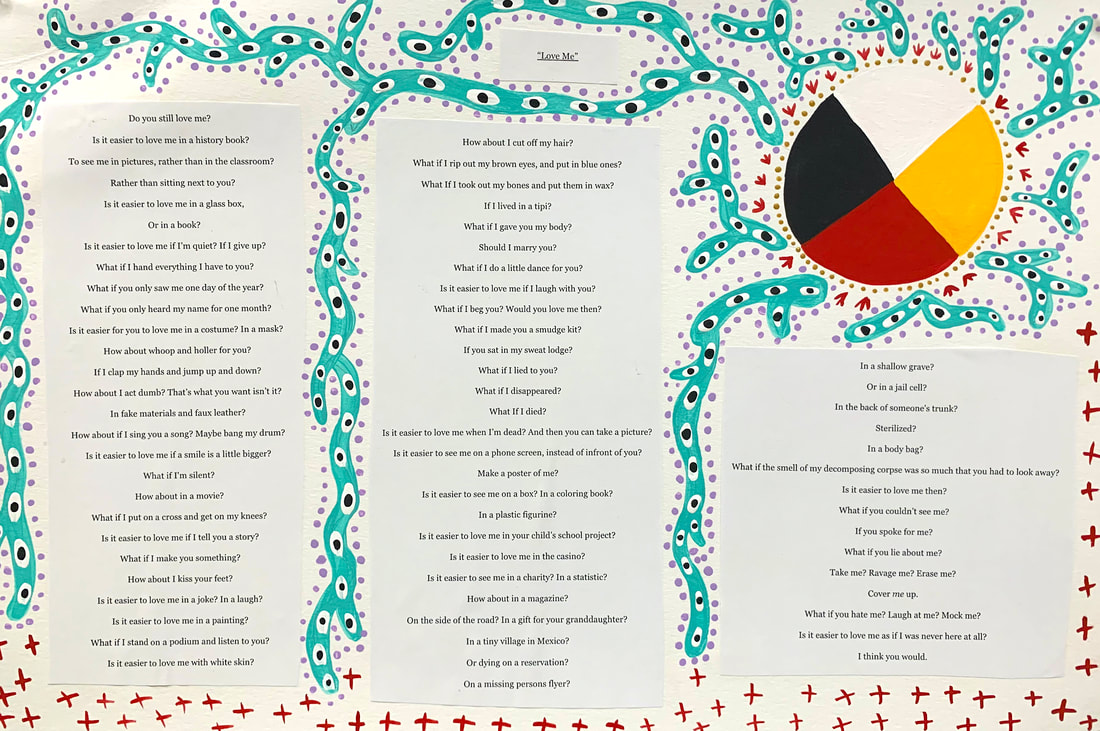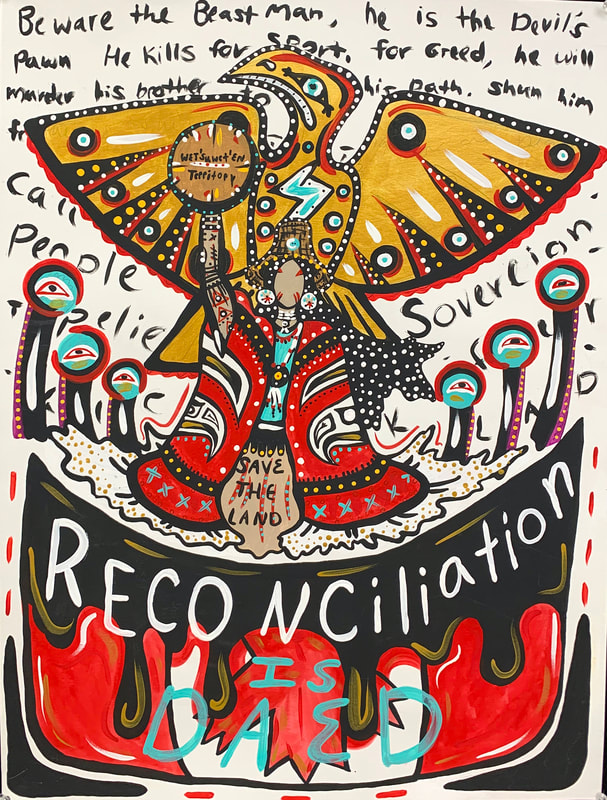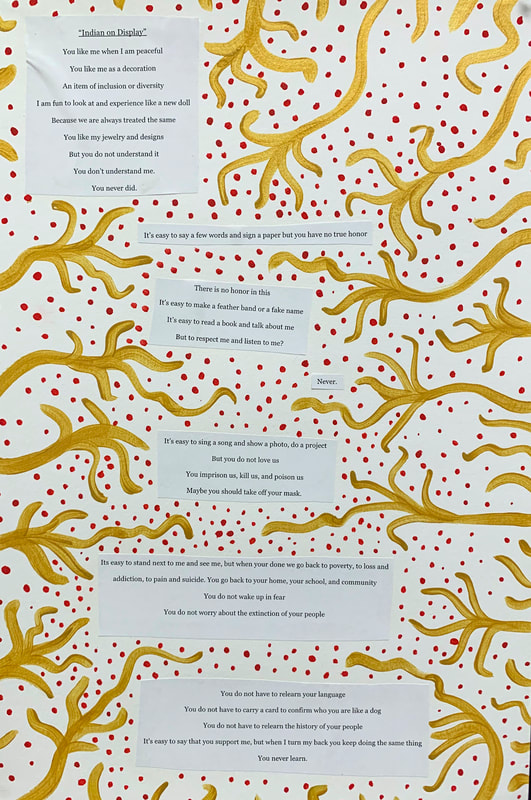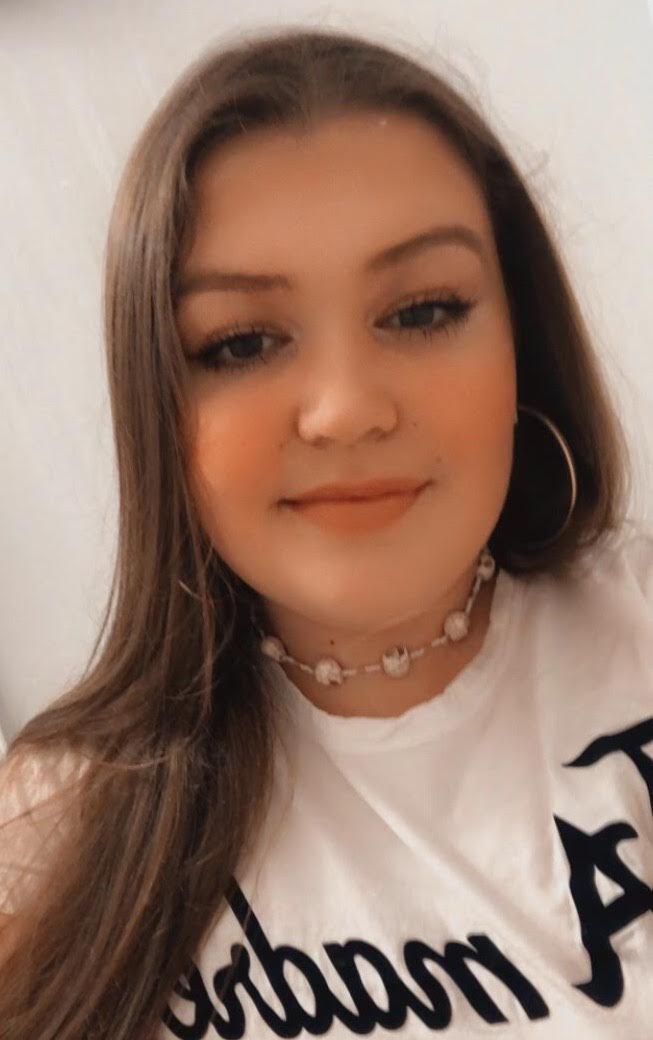MITAKUYE-OYASIN
All My Relations
“Mitakuye Oyasin” means “All My Relations”. In Indigenous cultures across America and Canada, all my relations means the connection between everyone; all directions, cultures, and lands. It means that everything is connected to us, from the grass, to the sun, from the sand, to the rivers. What we do affects us all. Thus, the purpose of my series is to bring to light the consequences of non-Indigenous America, Canada, South America, and Hawai’i’s actions on Indigenous communities and the importance of knowing about them. What we do affects everyone. That means pollution, colonial instutituions, racism, sexual assault, and generational trauma. The history behind these movements goes all the way back to 1492, the year Europeans came to Turtle Island, what we know today as the Americas. And for years, the new colonial ways of life destroyed, imprisoned, enslaved, and oppressed Indigenous peoples. Today I present a series of how all my relations represents the effects of these happenings. We are all related in the eyes of the Creator, but we hurt one another. I intend to educate my community about this. To bring to the surface that the land we walk on, once belonged to someone else. The streets we use, the views we enjoy, are stolen. And finally, the trials Native America faced in 1492 still exist today. That Indigenous people did not die off and exist outside of a movie screen or museum artifact. We are more than a conquest or a story in a history book. That we survived cultural genocide and forced relocation. We still exist, we are still here, we are resilient.
Decolonization
The Movements of Decolonizing and Returning to Traditional Ways
18 x 12 inches
The Movements of Decolonizing and Returning to Traditional Ways
18 x 12 inches
This piece is about a movement within individuals and groups of Indigenous people who are trying to revive traditional ways and lifestyles, like myself. Although some see this as “reverting” back to “savage” ways or “backwards thinking”, it is a way to decolonize. To derobe our manufactured selves of colonial constraints and to allow ourselves to be who our ancestors wanted us to be, free Natives. To relinquish colonial ways of thinking, to love our Native spirit. But for too long White America believed that they harbor the “correct” way of life, the most civilized, and important state of mind and race. But this movement challenges that. For example the unappreciation of respecting land and water as we see with the Amazon and Mauna Kea. We are reclaiming our identity, coexisting with nature, being unashamedly Indigenous and proud. This movement points out that the culture that was deemed “savage” and “animalistic” because of Native’s close relations with nature, which now are is the more sustainable way of life. The way to preserve nature. Now, there is veganism, recycling, biodegradability, and more. But Indigenous cultures around the globe were practicing that for generations, but then were prevented from doing so. These ideas were all a part of Indigenous life, including LGBTQIA+ identity. Two-Spirit peoples have been alive and respected in Indigenous culture around the world. Now that it is accepted, we are visible and taking back that unique identity of Indigenous, gender, and sexuality. Thus, this painting represents this movement entirely, and how I see it. It shows a non-binary, fluid, Two-Spirit, Indigenous person taking off their Converse to put on moccasins. There is a smog-filled and polluted city behind them, what American society has become. But where they are, there is plant life and knowledge, representing that there is extensive knowledge of nature in traditional Indigenous ways. I created this to represent the importance of learning and teaching Indigenous coexistence with each other, nature, and the world. Of reclaiming Indigenous identity and presence in the U.S. and Canada.
|
“Where Are My People?”
~ Juliette J. Gagnon “Identity” Where am I? Lost genetics. Controlled genetics. Lost blood. Free blood? From genocide. From murder. From “mixing” From death comes life? I am life, they are life, but where are they? Dead. Culture is lost. Love is lost. And where am I? Where are they? Please don’t forget them. |
|
Power
If I have found myself, Do I make them proud? Am I sacred? Could I be sacred without them? I am scared without them. Because they are me, and I them. They live inside me I am their memory I live and breath the message And I will never leave you alone Because your sins live forever And our pain in endless |
For the Women and Girls
detail |
|
Protest
3 x 3 inches |
Still Here
3 x 3 inches |
|
Aki
The Land Rivers long Grass tall Hair braided Earrings long Dark hooves Sharp horns Tongue like thorns Heart like drum Beat like the spirits above Dark skies- Dark eyes Am I sacred alone? I breath through the mountains Hear the people call These four direct my love My hope is not gone My anger still breaths The land speaks to me I am not alone. |
Black Snakes
12 x 18 inches
12 x 18 inches
|
The Fight
Does this vastness change me? Am I not someone without them? Their space changes me, but does not teach me Laugh but I am unchangeable These scars are hundreds of years old Your smile is young Weak. But my strength is infinite I have them But you are alone You are deaf to the song, but I am not You are little without yours You are alone without your ideas But I am strong alone We have always been alone, until yours came We had aki My unison lies in the tall grass of the plains In the cracks of the mountains In the colors of wild fish in the stream In the breath of the otter In the song of the eagle In the beat of the drum In the scream of the warrior In the taste of clean water In the blood of our youth In the needles of the pine In the smell of smoke In the slither of a snake We are in the antlers of the deer The tracks of the bear The feathers of the hawks In the fur of the horse The petals of flowers The dust of the desert The spine of the eel The claws of the weasel The morning frost The veins of a leaf The mud of clay In the bones of my people We are everywhere In the feeling of wind in your ear In the whisper of the wind I am in you I am in your path and in your future You will never be alone Our power is infinite. |
Aloha i ka ʻāina
The Mauna Kea Movement of Hawai’i
20 x 21 inches
The Mauna Kea Movement of Hawai’i
20 x 21 inches
This piece represents the movement in Hawai'i to protect the sacred lands of the Mauna. This movement arose after the construction of an 18-story, or thirty meter telescope (TMT) on a dormant volcano, which is sacred to Hawai'i people. From the unjust annexation of the islands, there has been mass destruction of Hawai’in Native land and culture. With the colonization of their lands, came foreign animals that destroyed the natural environment such as cockroaches and rats. There is mass construction of hotels, resorts, and mansions that have destroyed sacred lands and pushed Native Hawai’ins into poverty and devastation. The government of Hawai’i has neglected Indigenous peoples’ voices and their way of life. With that, came the banning and criminalizing of Native Hawai’in culture in 1896. From that time on, Indigenous Hawai’ins have faced tragedy after tragedy and are still fighting to protect and preserve their culture. This movement, “Protect Mauna Kea'', is just one. It means saving Mother Nature, and preserving sacred lands and sovereignty. To take away the Mauna, is to take away the rights of the people. In my painting I chose a woman because from my experience of learning about Hawai'in oral history, the Mauna is a mountain and there are many feminine qualities about the Mauna. Sometimes the land and mountains can be considered the mother of the people, just as the land can birth tribes such as the Lakota. The beliefs devote kindness and aloha (love) to her, to honor her through care and preservation. But people are trying to destroy that. We saw this same disrespect and destruction of the Dakota lands, with the Dakota pipeline, approved by the Trump administration. There is a consistent lack of respect for sacred land from non-Indigenous governments. They are not respecting the ka poe (the people). I feel that it is important to be aware of these protests because they affect us all, because if Natives are treated like this in one place, the government will treat everyone like that. This painting is meant to represent that fight and show a more fragfile look at Hawai'i, a mother with child, asking for the world's help and respect. She is ka aina, we are ka aina, aloha i nā kānaka.
|
No Church in the Wild
When all is conquered, taken, stolen Did you find yourself? Did happiness greet you with open arms? Are you still the smartest when you are all alone? Or the best? Can they worship you when you are the only one here? When my brothers and sisters are dead, gone, are you fulfilled? In the final, did you succeed? Can there be love with only one? Did you learn what you wanted? Did you win? Is the holiest of us all, the richest? Is the godliest man, the wealthiest? Is this what your God wanted? Well, don’t get used to the light here because it is black where you are going Because? Your religion is greed. Your faith is in success. Wealth is your bread. Anger is your wine. These buildings are the Body of Christ Sin is your power. Do not feel at peace in this place We are coming. The dead have spoken. And there is no church in the wild. |
|
Aliens and Indians
Spaceship People Boats and Ships, water and sky Brown skin - Green skin Black eyes - Brown eyes Landed hear, discovered this place We are different but we come in peace Looks like em’ must be em’, right? Space battles here, in space and on Earth Can you feel the radiation, from what you hate? Can’t understand my language. That’s okay. Just question my existence. Just kill me instead. Just make me speak your language. That’s okay just change me. Eliminate my existence. Change my beliefs. Fake my ceremony. Try to make me you, but I could never be right? That’s the whole point. I’m not you. But it’s easier for you to love me if I'm sort of like you. Priest stop killing my vibe Leave us alone. Go on to another planet. Put me in a movie maybe it will make you feel better But me on a reservation maybe you’ll feel safer Study me, look for me Welcome to Earth, we love everyone here. We were here all along I’m right next to you Welcome home. This is Turtle Island, We do not come in peace Neither did you. |
Kwe Story
18 x 24 inches
18 x 24 inches
This is a painting about Indigenous women. It has to do with the MMIW movement but also the individual fight that these women face everyday. That is the sexual harassment of men. The cat-calling, sexualization, and abuse of them. I believe that the main reason for such things is from the history of America’s treatment of women of color. From the beginning of Curiosities to American movies, fashion, and Halloween costumes. Curiosities were places where Natives and Black women, men, and children were forced onto displays in colonial societies. They are poked and prodded. Even exposed in front of crowds of people. Their skin, teeth, and eyes were examined like animals. This idea of “examination” was also carried into the selling of slaves in the U.S. at auctions. It was also carried into circuses and the film industry. Native women were given stage names such as “Squaw” and “Savage lady”. Many were forced to perform and participate in the fetishizing of Idigenous women. That their “wildness” and “savage” nature made them more attractive and sexual. This then was incorporated into the movies of America and Canada. Such as the 1953 version of “Peter Pan” all the way to “North” 1994. This corresponds with the portrayal of people of color in American pop culture. The humiliation and dehumanization of people was accepted and comictalized. And Native women feel the brunt of that. They deal with the fact that they are 50% more likely to sometime in their life they may be raped or assaulted and murdered, then any other race in America. Pop culture is to blame, America is to blame. Because what we see on the T.V. screen or hear on the radio, bleeds into people perceptions of others and leads them to do heinous things. Thus this painting shows a woman trying to get away from that. Trying to swim, trying not to drown in a place that can kill her. That her own home isn’t even safe. Thus, Native women and all women have to protect and heal one another. That is why she reaches for another woman’s hands, in search of safety. In many tribes beliefs, the woman is sacred. She has the power to create, heal, and to survive. We must share the gift with each other, and help one another heal from the pain we have.
|
Two Face
Two Face Woman Dual identity and double spirit She walks in two worlds, yours and her’s She loves Him, Her, and Them Two Face Woman Can you feel your power? You are strong because you are both You have multiple spirits You are sacred You will never stop There are millions of you You are eternity You are the product of the earth and universe From dirt and stars You are valid Valiant You are the Two Face Woman You are Both You are Everything. |
|
Bells and Bones
Revenge. Clink clink Knock knock Smack Can you hear them? Can you hear those? Like bones - like bells They knock together as the knees At the elbows At the ankles The wrists Can you hear the death Can you hear them crawl from the ground Can you hear phalanges on marble? Can you hear them in your prayer? Can you hear them in the pledge? In the laws? Broken and smashed Can you hear them call for you Can you hear the click clock of them together They come in the night as you did They are cut and shot Beat and enslaved They are just people like me and you But something happened Who could have done such a thing? you. |
El Violador Eres Tú
A rapist in your path/in your way
18 x 12 inches
A rapist in your path/in your way
18 x 12 inches
This piece is about the “El Violador Eres Tú” worldwide movement. I chose to incorporate it into the series to honor Indigenous women all over the world, not just where I am from. As my “Not Forgotten” piece represents the sexual assault, rape, and abuse of Native women, girls, and Two Spirit people, this movement also incoroporates that as well. The movement originated in Costa Rica, Mexico hence the Spanish title. A place where women suffer from the same abuse as Indigenous women in America and Canada. I also mean to highlight the fact that the majority of Latinx people are Indigenous. The Americas is home to Natives, it is Native land. Thus the abuse and oppression of them is the same everywhere. This movement and song spread around the world to empower women. To show all women that their rapist is to blame, not what they were wearing or what time they were out. That the institutions, and criminal justice systems, and police officers, and toxic masculinity, and rape culture of their countires are to blame. The movement also means a lot to me because I am a woman. Almost every girl and woman I know has been affected by this, traumatized and humiliated by this. I feel that what this song says is the truth. That the generational trauma of the oppression of women stops with me. This picture enforces that idea.
to edit.
to edit.
|
Her Story
Kookum Grandmother Aunt Mother Sister Cousin Daughter Chenoa The love I have for you is unconditional I am the product of your fight and pain I love you for who you are and I carry your message I carry the love you had even when there was none for you I love you for the strength you gained from life I am fearless because of your survival I will never forget the pain you bore and the scars of an unforgiving home I heal from you loss and forgotten pain I heal the trauma and death that plagued us I honor the beauty that you bring us I represent our silent fight You are the medicine |
|
The Apology
I am sorry, I am scared. But not as scared as you. Your fear causes destruction My fear is from love, my fear fights My fear is not sorry. I will fight you until the end of time Because my love is stronger than yours Your systems are invisible Your ideas crumble Our love is forever I am not sorry I will never be sorry. I am not sorry for uprooting your lies I am not sorry. |
Wet Su Wet En
detail |
For the Women and Girls
10 x 10 inches
10 x 10 inches
|
Aloha i ka aina
detail |
Don’t Forget About Me
My fight is for you as it was for them. I live for you I teach for you I love you You are the future of the people You carry the message The land, the language, the love We live in you Your honor is what matters Youth is growth Even when we doubt you We love you Roots are long, like your braid A shell is more important than it seems Your blood is the color of life The color of the spirits You are sacred You are the fight now Don't forget about me. |
|
Always Watching
We are always watching We watch as you sleep As you drive to work As you build a house, a building We watch from under the ground We watch from the glass boxes in the museum We watch from the mass graves We watch from our place under the dirt beneath your feet We watch as you drink the water and take the plants We watch as you burn the trees We are always watching We watch as you smile and laugh As you stand for the flag We watch as you pray and sing We watch as you enjoy what you stole As you live free a guilt and sadness We watch We watch as you walk alone in the night We watch as you eat the fruit of your sin We watch |
Save the Amazon
The tragedy of the Amazon Rainforest, and the people dying with it
20 x 20 inches
The tragedy of the Amazon Rainforest, and the people dying with it
20 x 20 inches
This piece is about the tragedies in the Amazon rainforest and the protestors fighting to save it. I chose to paint a dead Kayapo woman floating down the Amazon River with her child. She is one of the many sovereign tribes of the Amazon and she represents their fight to keep what is rightfully theirs. I chose to surround her in death as well because the Indigenoues peoples of the Amazon are dying with the forest. The fire burns hundreds and hundreds of years of Indigenous civilization in these forests. They burn homes of animals and of people. This year, we learned that the forest was set on fire deliberately by farmers in an attempt to burn away the brush to clear land for cattle. For hundreds of years, the Indigenous people of the rainforest have been coexisting and protecting nature. They have preserved her and maintained an essential balance. They also renounced colonial rule, religion, and society. But this has now been destroyed. The pain for them is greater than any other, they have protected and preserved the surrounding nature for generations. To protect the land is to honor her, and this is an idea that is consistent throughout all tribes of the americas, but something the colonial government lacks. I created this painting to represent that pain, it is one of the worst things that happens to Indigenous people, to lose a home, to lose something that is more precious than the Vatican. Our land is our life and without it we are nothing. I feel that the Rainforest is very important to spread awareness about because it is vital for the natural world and its continuance into the future. It keeps the world alive, systems working, and most importantly it is part of nature that keeps us alive. I attempted to incorporate feminine energy into my series. Thus, the river that the woman is in resembles a part of the human body associated with birth and feminine energy. This unites the precious birth of the Indigenous people in the world, with the unjust and greedy death of Indigenous populations and of sacred land. It represents the generations of plant life destroyed and those that will disappear and how that will affect us, although we think it won’t, inevitably.
Coronavirus in Indian Country
COVID-19
18 x 24 inches
COVID-19
18 x 24 inches
This piece is about the COVID-19 in Indigenous communities. Also about the protests surrounding it. The painting shows a bright sun in the background. Traditionally in many plains tribes this represents hope, these are the tribes who are really being hit hard but this pandemic currently. There are also dragon flies in the rays, meant to represent the hope of the people and also the prayers for them. There is a woman too, continuing the theme of women’s influence in nature*, she is placing her dead child into the water. She represents the last of the spirit. The last of the hope of the people. Her child was the last of the people, the last to carry on the culture. There are bodies of Indigenous women, men, and children. They are dressed in modern Indigenous clothes. This image is not a representation of past events, but future ones. Ones that will happen if we do not support Indigenous people in this time. Due to the unfortunate fact that the U.S. government only funds 50% to some reservations, what they give to the rest of the United States for resources. They are only supported half way. Thus, causing Indian Country to be the most impoverished places in the country. And the fact that most reservations are on land that the U.S. found no use for, they land is almost infertile and useless. The forced relocation of Natives moved them to new lands, and non-prosperous lands. Thus, to grow food in the dry desert of the Navajo Reservation (the largest in the country), for example, is impossible. And there are close to no stores, businesses, or towns in these reservations. They are isolated, no running water, electricity, or plumbing, because they are not funded. However some reservations own the land that is used for roads, checkpoints, and casinos. It appears that Native have control over “their” lands, whether it be reservation or land in trust. But they don’t. Reservation land is actually owned by the government, not the tribe. This land was and is owned by the government, set aside to keep the Natives. Essentially keep them there until they die off. But that didn’t happen. So they still have to fight to control the land, which the state and federal governments do not want. This piece represents the fight for that control; for if it is not allowed the wish of the American government through the 17th to 19th centuries, will get what they wanted, no Indians. We will disappear without the help of others and each other. Thus, it is important to respect Native wishes to close down travel through their reservations, to preserve a dwindling and suffering population.
|
When It’s Cold
I hope when it is cold, your Fathers keep you warm I hope all the lies and loss keeps your feet from turning black I hope the dead children and stolen love keep your eyes from freezing shut I hope the red dresses cover your purple hands I hope you stay warm I hope the death and genocide keeps you from falling asleep Don’t fall asleep yet I hope the songs of the dead keep your ears from going deaf I hope your laws rap you tight I hope you don’t suffocate I hope your plastic stops the decay I hope your flag is warm enough to last the night I hope your gun is strong enough to build a fort I hope your brothers can keep your head above the water I hope your heart beats louder than the drum I hope it’s loud enough to stop the voices I hope your hate holds you high up so that that wolves don’t get you I hope your mask keeps your skin from peeling And falling away I hope the crows stay away, like you didn’t Are your slurs mean enough to fight off the night? I hope your tongue does not stop, I hope it doesn’t fall off I hope when it is so cold, they will keep you warm I hope your people’s arms are long enough to reach you I hope when the ice falls, the angels will catch it for you Is your cross strong enough to last the winter? I hope the police can keep you from the ice I hope your beliefs can stop the shivers I hope your arms do not give out when the night comes I hope your love keeps your teeth from rot I hope your style can fight the rain that comes tonight I hope your hair doesn’t fall out Can your tank make a fire? I hope you are safe from the visions of those who are forgotten I hope the monsters do not get worse at night I hope you can last the night I hope the moldy scriptures and texts do not become too much Do you smell it? The rot? I hope your suit is good enough to stop the smell I hope you do not sink into the black like we did I hope your tears are strong enough to keep you from thirst I hope your pride keeps you from hunger I hope it lasts you through the month I hope your money is thick enough to make a roof I hope you have enough books to soak up the blood I hope you can drink your oil I hope you can breathe in the gas I hope your campaigns save your mind Don’t go mad. I hope the cold does not kill you like you killed us Say a prayer, maybe it will all stop I hope the night doesn’t come for you I hope the cold doesn’t get you I hope it doesn’t freeze I think it’s getting colder or maybe you would learn of the Cold |
Peace
10 x 10 inches
10 x 10 inches
|
The Bounce
Feel you heart Does it beat like the drum? Does your heart thump thump? Thump thump? Like the chief? Like buckskin on grass? Like cones on fabric? Like bells and bones? Like the ceremonies? Do you feel alone? You are never alone. They are always here. The people are always here. Bounce like your heart depends on it The bounce is for you For us. For them. |
Love Me
Do you still love me?
Is it easier to love me in a history book?
To see me in pictures, rather than in the classroom?
Rather than sitting next to you?
Is it easier to love me in a glass box,
Or in a book?
Is it easier to love me if I’m quiet? If I give up?
What if I hand everything I have to you?
What if you only saw me one day of the year?
What if you only heard my name for one month?
Is it easier for you to love me in a costume? In a mask?
How about whoop and holler for you?
If I clap my hands and jump up and down?
How about I act dumb? That’s what you want isn’t it?
In fake materials and faux leather?
How about if I sing you a song? Maybe bang my drum?
Is it easier to love me if a smile is a little bigger?
What if I'm silent?
How about in a movie?
What if I put on a cross and get on my knees?
Is it easier to love me if I tell you a story?
What if I make you something?
How about I kiss your feet?
Is it easier to love me in a joke? In a laugh?
Is it easier to love me in a painting?
What if I stand on a podium and listen to you?
Is it easier to love me with white skin?
How about I cut off my hair?
What if I rip out my brown eyes, and put in blue ones?
What If I took out my bones and put them in wax?
If I lived in a tipi?
What if I gave you my body?
Should I marry you?
What if I do a little dance for you?
Is it easier to love me if I laugh with you?
What if I beg you? Would you love me then?
What if I made you a smudge kit?
If you sat in my sweat lodge?
What if I lied to you?
What if I disappeared?
What If I died?
Is it easier to love me when I’m dead? And then you can take a picture?
Is it easier to see me on a phone screen, instead of infront of you?
Make a poster of me?
Is it easier to see me on a box? In a coloring book?
In a plastic figurine?
Is it easier to love me in your child’s school project?
Is it easier to love me in the casino?
Is it easier to see me in a charity? In a statistic?
How about in a magazine?
On the side of the road? In a gift for your granddaughter?
In a tiny village in Mexico?
Or dying on a reservation?
On a missing persons flyer?
In a shallow grave?
Or in a jail cell?
In the back of someone's trunk?
Sterilized?
In a body bag?
What if the smell of my decomposing corpse was so much that you had to look away?
Is it easier to love me then?
What if you couldn’t see me?
If you spoke for me?
What if you lie about me?
Take me? Ravage me? Erase me?
Cover me up.
What if you hate me? Laugh at me? Mock me?
Is it easier to love me as if I was never here at all?
I think you would.
Do you still love me?
Is it easier to love me in a history book?
To see me in pictures, rather than in the classroom?
Rather than sitting next to you?
Is it easier to love me in a glass box,
Or in a book?
Is it easier to love me if I’m quiet? If I give up?
What if I hand everything I have to you?
What if you only saw me one day of the year?
What if you only heard my name for one month?
Is it easier for you to love me in a costume? In a mask?
How about whoop and holler for you?
If I clap my hands and jump up and down?
How about I act dumb? That’s what you want isn’t it?
In fake materials and faux leather?
How about if I sing you a song? Maybe bang my drum?
Is it easier to love me if a smile is a little bigger?
What if I'm silent?
How about in a movie?
What if I put on a cross and get on my knees?
Is it easier to love me if I tell you a story?
What if I make you something?
How about I kiss your feet?
Is it easier to love me in a joke? In a laugh?
Is it easier to love me in a painting?
What if I stand on a podium and listen to you?
Is it easier to love me with white skin?
How about I cut off my hair?
What if I rip out my brown eyes, and put in blue ones?
What If I took out my bones and put them in wax?
If I lived in a tipi?
What if I gave you my body?
Should I marry you?
What if I do a little dance for you?
Is it easier to love me if I laugh with you?
What if I beg you? Would you love me then?
What if I made you a smudge kit?
If you sat in my sweat lodge?
What if I lied to you?
What if I disappeared?
What If I died?
Is it easier to love me when I’m dead? And then you can take a picture?
Is it easier to see me on a phone screen, instead of infront of you?
Make a poster of me?
Is it easier to see me on a box? In a coloring book?
In a plastic figurine?
Is it easier to love me in your child’s school project?
Is it easier to love me in the casino?
Is it easier to see me in a charity? In a statistic?
How about in a magazine?
On the side of the road? In a gift for your granddaughter?
In a tiny village in Mexico?
Or dying on a reservation?
On a missing persons flyer?
In a shallow grave?
Or in a jail cell?
In the back of someone's trunk?
Sterilized?
In a body bag?
What if the smell of my decomposing corpse was so much that you had to look away?
Is it easier to love me then?
What if you couldn’t see me?
If you spoke for me?
What if you lie about me?
Take me? Ravage me? Erase me?
Cover me up.
What if you hate me? Laugh at me? Mock me?
Is it easier to love me as if I was never here at all?
I think you would.
Wet’ Su Wet’ En
18 x 24 inches
18 x 24 inches
|
Indian on Display
You like me when I am peaceful You like me as a decoration An item of inclusion or diversity I am fun to look at and experience like a new doll Because we are always treated the same You like my jewelry and designs But you do not understand it You don’t understand me. You never did. It’s easy to say a few words and sign a paper but you have no true honor There is no honor in this It’s easy to make a feather band or a fake name It’s easy to read a book and talk about me But to respect me and listen to me? Never. It’s easy to sing a song and show a photo, do a project But you do not love us You imprison us, kill us, and poison us Maybe you should take off your mask. Its easy to stand next to me and see me, but when you're done we go back to poverty, to loss and addiction, to pain and suicide. You go back to your home, your school, and community You do not wake up in fear You do not worry about the extinction of your people You do not have to relearn your language You do not have to carry a card to confirm who you are like a dog You do not have to relearn the history of your people It's easy to say that you support me, but when I turn my back you keep doing the same thing You never learn. |
“Where Are My People?”
Mini series of original poems by Juliette Gagnon
These are a series of printed poems with small painted pictures. These are poems written by myself, which take a more personal look at Indigenous identity. Several of them address America directly, and the others address fellow Indigenous people. Native who face the same trials as I. Such as sexual identity, American identity, racial discrimination, self-image, and the fight to protect who we are. These poems are very important to me because they are the core of this series. The core of the hidden individual movement inside every Indigenous persona living in a colonial-controlled society. Our existence is our resistance. To wear beaded jewelry in a school is a protest. It is a remembrance of the beaten, abused, raped, and converted children of Indian schools in America and Canada. To honor the hanged and enslaved ancestors. The tortured and sterilized souls who walk the land in pain. We walk again. To walk free in a city or in my home town without shame is an ancestor’s dream. But the fight is not yet over. With this identity comes the backwash of years of racism and antagonisation of Indigenous Americans. My poems represent who I am entirely. How my struggle is connected to all of my relations, how the hate from my racist classmates and people on the street connects us, how my love for the culture connects me with thousands of others youths. There is a connection between everyone and everything, invisible but palpable. Whether I am hated or accepted, we are connected. These poems are my part of Mitakuye-oyasin; who I am in the directions, my place on the timeline of years of Indigenous struggle. My roots in the ground connected to the blood in my veins. This is me.
ARTIST STATEMENT + BIO
|
My art is how I heal myself. Healing generational trauma and grief. It represents my path in life grappling with my fading identity as a mixed Indigenous person in America, who I am, and what I stand for.
My art is the product of this individual movement and the decolonization of my manufactured self. My ancestors speak through me and I through my art. The pieces discuss taboo subjects surrounding Indigenous struggles around the world. Representing movements against racism, destruction of our natural environment, tribal sovereignty, and Indigenous peoples and women’s rights. Due to lack of resources, my work is the only way I can be a part of the protest. I believe that it is my duty to honor my ancestors through educating my community about these issues. I believe that it is important and relevant that we learn of the coexistence with nature and the value of natural law that Indigenous people uphold. My art embodies this promise to never forget. The series I am presenting is named Mitakuye-Oyasin which translated to English means The Four Directions. The name is meant to represent all people, especially our Indigenous relatives and their current struggles. In many prayers we say this thinking of everyone, not just our own, to heal and protect one another. It highlights that in each piece there is a movement that affects everyone, not just our Indigenous brothers and sisters. In the pieces themselves, I use a variety of mediums. My style is very colorful and a unique mix of traditional Ojibwe-styled art and modern semi-realism, combining traditional and modern technique. Each piece is a part of me and the people. They speak of many issues that we face each day and internally as citizens of colonized and conformed societies. Each piece honors them and comes from love and faith fos past and future generations, because our honor lies in the children who are fighting on the frontlines. Background: I am from a small town in the Berkshires, Massachusetts. I come from a mainly European, but also Indigenous family. I am very close with my grandmother and her mother, my great grandmother. Her mother left Canada when she was a teenager. From then on she lived a difficult and harsh life in the States, so did her children, and their children. Her father was an Indigenous man, or “Indian man” as she says, from Canada. She says he had long black hair and dark skin, that he was a quiet man. My father’s father is also part Native from Canada. My last name is Gagnon. Gagnon is a common last name given to Natives converting to the church of God in Canada. It was also the name of the town they lived in, in Quebec. My great grandmother’s maiden name is also Gagnon, from another family. Thus, a very common last name. My father taught me a lot about the culture and the ways of the people. He had long black hair from the minute I could remember. He was a unique father in that way, because he had long hair, wore earrings, and bone necklaces. And he faced a lot of criticism for that, as did I in my school. But I loved him for it, I loved the powwows, music, art, and traditions. And even though the tribes of my family are long gone, I know where my heart belongs. Honoring my ancestors is through art, relearning the traditions, language, and songs. This series represents that dedication and the fight to keep the culture alive, to exist and resist. |
Juliette Gagnon is a graduating senior who has a range of artistic techniques, such as traditional Indigenous beading jewelry, making ceramics, and painting traditional Ojibwe-style combined with semi-realism. She loves reading and fighting the power. This fall Juliette plans on majoring in environmental sciences and minoring in Indigenous studies at Russel Sage College in Troy, New York.
Materials used in series: watercolor paint, acrylic paint, watercolor paper, printer paper, canvas, seed beads, turquoise beads, thread, gouache, gesso, cowrie shells, jingle cones, wire, pheasant feathers. |
CONNECT ON SOCIAL MEDIA
Instagram @aakwaadizi224
